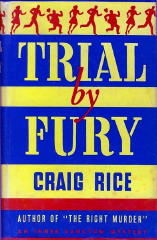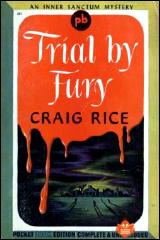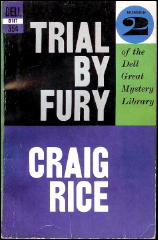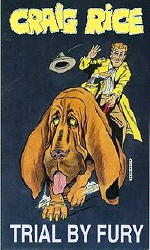Tue 1 Sep 2009
A Review by David L. Vineyard: CRAIG RICE – Trial by Fury.
Posted by Steve under Reviews[5] Comments
CRAIG RICE – Trial by Fury. Simon & Schuster, hardcover, 1941. Paperback reprints include: Pocket 237, 1st printing, October 1943. Dell D187, Great Mystery Library #2, 1957. International Polygonics, 1991.

When Jake and Helene Justus escape the hot summer in Chicago, they find themselves in the Jackson County Court House in Jackson, Wisconsin, just in time to witness the murder of ex-Senator Joseph Peveley (“It can’t be murder, that’s the second murder in thirty-two years.”), and naturally Jake being Jake, he ticks off the less than brilliant local lawman and finds himself jailed as a material witness. “It’s none of my business, and I don’t know that I care very much, but who might have wanted to murder your ex-Senator?”
So the leggy blonde Helene does what any sensible wife would do. She sends to Chicago for that rumpled, red haired, bibulous Don Quixote of the law, the one and only John J. Malone, defender of the weak, savior of the downtrodden, and patron of more bars than the Bar Association can shake a stick at, who arrives by bus, hot bothered, and as usual brilliant.
In fact, before he even gets Jake and the local prosecutor (who has been arrested by the same lawman) out of jail, he finds the murder weapon and shows how the crime was committed.
Now all he wants to do is get himself out of Jackson and back to noisy, hot Chicago: “Here they are living in the age of innocence, and in Chicago were living in the age of consent.”
But then when he goes to cash a check and they blow the bank out from under him, it delays his departure.

Malone shut his eyes again. “I am too dead,” he told her.
But he isn’t, though someone else is, and as the doctor remarks the city has about four murders every thirty-two years. “There’s two more coming.”
So reluctantly Malone finds himself delving into the case, and being Malone he naturally does it between drinks, with a little help from a local who seems to be under the impression Hoover is still in office and Prohibition is still in effect:
“Don’t you like it?”
“I like it, but it has a way of sneaking up on you when you don’t expect it …”
And before long, there is yet another murder, one which is preceded by Malone jumping in a river to save a damsel in distress; a body found buried under a concrete slab in a most respectable basement; a less than respectable young lady is killed; and Jake ends up running from a lynch mob with Malone and a slightly inebriated bloodhound named Hercules on his trail, with a bottle of Dollar Gin their only clue.
Of course Malone solves it, if only after polishing off the Dollar Gin and the local madhouse burns down while he and Hercules send a lynch mob packing.
In the same instant, Hercules, somewhere in the bushes beyond sent up a heart rending howl.

An uneasy, frightened movement began in the crowd, slowly men began pulling away in little groups and starting for their cars. A piece of loose tender in the burning building behind Malone suddenly blazed up and sent an unearthly light over the scene. In the same instant Hercules let loose with another dreadful howl, and the movement toward the parked cars became a panicked rout.
Malone spun around and threw the cigar in the smoldering flames. There wasn’t much difference, after all, between a lynch mob and a jury in a criminal court. You could convince ’em, or you could reason with ’em, or you could pray with ’em, but the simplest thing to do was to scare ’em. He wished he could take Hercules into a courtroom with him sometime.
Trial by Fury may well be Rice best novel in the Malone opus. It is funny, involving, fast moving, the detective work is genuine, and the humor never flags or falls flat.
The characters belong to that bucolic Hollywood version of an America that never existed, but Rice and Malone both know that under that facade of 4th of July picnics and Sunday morning services there are motives and actions enough for murder most foul.
Jake is his usual less than bright self, and Helene surely the most beautiful wife a lucky fool could have. Malone sulks, pouts, drinks, smokes his cigars, looks rumpled, and proves brilliant and in this one even falls in love — albeit with an unlikely soul mate — Hercules, a giant half Bloodhound, half Great Dane, who is possessed of a courageous soul and a detective’s unwillingness to ever give up the scent.

“What do you suppose he’s dreaming about?” Helene asked.
“Who, Malone or Hercules?”
She looked down at the sleeping pair and shook her head.
“I wonder how that dog found his way into the car?” she mused.
Jake took her free hand in his and looked at her tenderly.
“Love,” he said. “Will always find a way.”
And in all honesty, I don’t think I can top that. Find this one and read it. It is the screwball school personified, a first class piece of detective work, a drop dead funny novel, and Malone and Hercules are one of the great romances in literature. Unless you are a cat person, or have a heart of stone.
September 2nd, 2009 at 4:46 am
Trial by Fury was the Haycraft Queen selection for Rice’s best book. My favorite is still The Corpse Steps Out, but to each his own.
September 2nd, 2009 at 10:19 am
What I don’t understand is why more of Craig Rice’s brand of screwball comedy mysteries weren’t made into screwball comedy movies.
It was a very popular film genre at the time, and in TRIAL BY FURY, you also have the dog, which could be played for lots of laughs.
Of the Jake & Helene Justus/John J. Malone books, only two were made into movies:
HAVING WONDERFUL CRIME, 1945, with George Murphy & Carole Landis as the Justuses and Pat O’Brien as Malone.
(Which I reviewed here: https://mysteryfile.com/blog/?p=99. While I said that Carole Landis is wonderful, I also pointed out that the movie is not much based on the book.)
… and THE LUCKY STIFF, 1949, with Brian Donlevy as Malone (and no Justuses).
If I’m missing any, let me know.
September 2nd, 2009 at 12:20 pm
It’s a mystery to me. Rice was a major writer, popular (she was even on the cover of Time), and worked in Hollywood. The Chicago setting and the characters of Malone and the Justus’s were naturals for the screen.
It could just be the whole right time, right place thing just never happened. Why did they virtually ignore the plots and style of the bestselling Perry Mason books in the Warren William films? For that matter why only three Nancy Drew films just as they were getting into the swing of the character?
Of course once in a while someone did something brilliant like changing Fred Nebel’s Kennedy to the female Torchy Blaine, but you have to wonder about some of the other choices. They filmed three of Clayton Rawson’s four Great Merlini books and didn’t use Merlini in any of them (though there were similar characters in all of them)
I would love to have seen Trial By Fury on screen. It’s cinematic as it is, and you can almost cast it with familiar character actors while reading it — that’s half the fun.
Lucky Stiff isn’t a bad little mystery although it took me a little to adjust to Brian Donlevy as Malone.
September 2nd, 2009 at 5:06 pm
A few things to note: Home Sweet Homicide was also filmed — a non-Malone and did very well. The filmed Withers-Malone series did not do all that well.
As David indicates, Hollywood at the time chopped up books no end to take to the screen. Having Wonderful Crime bore zero resemblance to the book. The Lucky Stiff was not a lot better in terms of fidelity.
I don’t think that there were any attempts to do the books right and that of course made for very uneven results. The same could be said of the radio program with much the same results.
September 2nd, 2009 at 10:12 pm
The funny thing is that fidelity to good books and plays always paid off for films with the likes of Gone With the Wind, The Maltese Falcon, Mildred Pierce, Lost Horizon, and The Wizard of Oz.
Though done on no budget, the three films in the I Love a Mystery series were very well done and faithful to their source, and the three Kane Richmond Shadow entry struck a nice balance between the pulp and the radio series.
Still, sometimes the powers that be were right. George Marshall’s remake of the Max Brand/Tom Mix Destry bears little resembalence to the original and is one of the brightest and most entertaining films of its period.